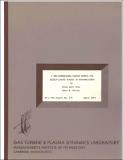| dc.contributor.author | Dang, Thong Quoc | en_US |
| dc.contributor.other | Massachusetts Institute of Technology. Department of Aeronautics and Astronautics | en_US |
| dc.date.accessioned | 2016-10-06T21:22:02Z | |
| dc.date.available | 2016-10-06T21:22:02Z | |
| dc.date.issued | c1983 | en_US |
| dc.identifier.uri | http://hdl.handle.net/1721.1/104697 | |
| dc.description | Includes bibliographical references | en_US |
| dc.description | Also issued as: Thesis (M.S.)--Massachusetts Institute of Technology, Dept. of Aeronautics and Astronautics, 1983. | en_US |
| dc.description.abstract | A practical design method for highly-loaded blades in an isolated cascade is presented in this thesis. The flow is assumed to be incompressible and inviscid. The upstream inlet flow condition is taken to be uniform. The present goals of this research are to provide a practical numerical code for the design problem, and a non-linear theory which can be easily expanded to three-dimensions. The theory is based in part on the Clebsh formulation. The blade profile is determined iteratively through the blade boundary conditions using a "smoothing" technique. A practical numerical code is presented for the design problem using "partial smoothing". The program gives very fast convergence solutions with satisfactory accuracy for practical solidity range. | |
| dc.description.abstract | A practical design method for highly-loaded blades in an isolated cascade is presented in this thesis. The flow is assumed to be incompressible and inviscid. The upstream inlet flow condition is taken to be uniform. The present goals of this research are to provide a practical numerical code for the design problem, and a non-linear theory which can be easily expanded to three-dimensions. The theory is based in part on the Clebsh formulation. The blade profile is determined iteratively through the blade boundary conditions using a "smoothing" technique. A practical numerical code is presented for the design problem using "partial smoothing". The program gives very fast convergence solutions with satisfactory accuracy for practical solidity range. | en_US |
| dc.description.sponsorship | This research was supported by the U.S. Air Force Office of Scientific Research, Dr. J. D. Wilson, Program Manager, contract Number: F49620-82-K-0002 | en_US |
| dc.format.extent | 125 leaves | en_US |
| dc.publisher | c1983 | en_US |
| dc.relation.ispartofseries | GT & PDL report ; no. 173. | en_US |
| dc.subject.lcsh | Turbomachines -- Blades. | en_US |
| dc.subject.lcsh | TJ267.5.B5.D36 1983 | |
| dc.title | A two-dimensional design method for highly-loaded blades in turbomachines | en_US |
| dc.title.alternative | Highly-loaded blades in turbomachines, A two-dimensional design method for | en_US |
| dc.type | Technical report | en_US |
| dc.identifier.oclc | 68927451 | en_US |
